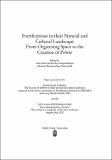Por favor, use este identificador para citar o enlazar a este item:
http://hdl.handle.net/10261/284990COMPARTIR / EXPORTAR:
 SHARE
BASE SHARE
BASE
|
|
| Visualizar otros formatos: MARC | Dublin Core | RDF | ORE | MODS | METS | DIDL | DATACITE | |

| Título: | Fluid fortresses in changing states: Tàta in southern Senegal (13th–19th centuries AD) |
Autor: | Canós-Donnay, Sirio CSIC ORCID | Palabras clave: | Táta Kaabu Fulaadu Mali Empire Casamance |
Fecha de publicación: | 2022 | Editor: | Dr. Rudolf Habelt | Citación: | Fortifications in their Natural and Cultural Landscape: From Organising Space to the Creation of Power: 69-82 (2022) | Resumen: | The term tàta is a Manding word designating a fortified political and military centre. In southern Senegal, tàta have been a key element in the articulation and conceptualisation of political landscapes through multiple polities since at least the 13th century. In a landscape characterised by fluid political territories and changing power arrangements, tàta marked the centre of a political unit and the presence of an armed ruler. Both power centres and rulers – and thereby the territories they controlled – could be subordinate to others, but the hierarchy of subordination fluctuated together with changes in regional power balances. The right to build a tàta was centrally regulated; as a result, periods of stability were marked by a limited number of fortifications, while times of central weakness resulted in an upsurge in the quantity of tàta. While varied in size and construction, some of these fortresses were very substantial, reaching up to 12 m in height and featuring multiple rings of walls. They fulfilled both practical and symbolic functions: they were often large defensive structures, capable of resisting sieges and attacks, but their very presence also indicated the existence of a state-controlled territory linked to Manding political traditions as opposed to a no-man’s land suitable for raiding. However, despite their sturdy appearance, tàta were often relatively ephemeral structures, with their existence limited to the reign of a particular ruler. In this chapter I explore the nature, location and roles of the network of tàta associated with the state of Kaabu in southern Senegal. | Descripción: | Edited by: Timo Ibsen, Kristin Ilves, Birgit Maixner, Sebastian Messal and Jens Schneeweiß.-- Papers presented at the International workshop ‘The location of hillforts in their natural and cultural landscape’, organised by the EAA Community on Fortification Research (COMFORT) Schleswig, March 5th/6th, 2020 and the EAA-session #448 (Budapest 2020) ‘Just a demonstration of power? The setting of strongholds within their landscape’ August 29th, 2020. | URI: | http://hdl.handle.net/10261/284990 | ISBN: | 978-3-7749-4374-2 |
| Aparece en las colecciones: | (INCIPIT) Libros y partes de libros |
Ficheros en este ítem:
| Fichero | Descripción | Tamaño | Formato | |
|---|---|---|---|---|
| Canos-Donnay_2022.pdf | 8,62 MB | Adobe PDF |  Visualizar/Abrir |
CORE Recommender
Page view(s)
270
checked on 03-may-2024
Download(s)
138
checked on 03-may-2024
Google ScholarTM
Check
Altmetric
NOTA: Los ítems de Digital.CSIC están protegidos por copyright, con todos los derechos reservados, a menos que se indique lo contrario.
